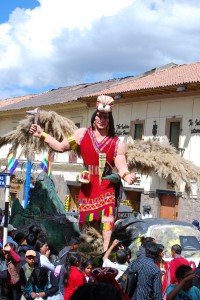Inca, a Statue and a Struggle

The Incas not only are an important part of Cuzco’s history, they are a basis of its economy and their memory can explode in controversy, even today.
Such is the case of the golden statue of a fiberglass Inca pointing outwards that Cuzco’s mayor Luís Flores García recently had placed on top of Cuzco’s classic, republican-style, fountain in its main square, replete with representations of swans. This act of officially honoring the Incas led to a conflict with the national Ministry of Culture and its minister, the prominent anthropologist Juan Ossio and with many people in Cuzco.
For a week or more, as the festivities leading up to the Day of Cuzco, the feast of Corpus Christi, Inti Raymi, and finally the celebrations for the centennial anniversary of Machu Picchu the fountain lay shrouded in wood framed plastic, although photos were placed on it.
When the plastic was removed and the statue was revealed, according to Dr. Ossio, it was thought the statue was simply a temporary representation of the importance of the Incas to this city at a time when Machu Picchu, its major economic draw, claimed 100 years of public attention.
But Mayor Flores announced the intention to leave the statue as a permanent addition to the plaza, a kind of “Incanizing” of a colonial and republican — creole — space that once was the ceremonial heart of the Inca Empire.

By doing this, Mayor Flores followed what the archeologist Helaine Silverman called an official policy of Incanization. This is not the first time statues of Incas in Cuzco have been criticized. As Silverman notes, the large statue to the great Inca Pachacutec that almost every tourist sees as they leave the city’s airport, bus terminal, or train station, standing high on a stone pillar in a traffic round, was severely criticized and challenged.
Silverman argues that Cuzco’s leaders have undertaken an official policy of Incanization that depends on presenting a seamless connection between the past and the present and that authorizes Cuzco’s elites as descendants of the Inca Emperors and Cuzco as the first capital of Peru. In this, they build on traditions that have depth in the city according to anthropologist Marisol de la Cadena.
While Silverman, and many local Cuzcqueños, complain that this policy increasingly makes the city into an “Inca theme park” there is, of course, more to the story.
Minister Ossio makes the case that Cuzco belongs, as an historical center recognized by UNESCO to all of humanity and that it cannot be changed without the appropriate processes of granting permission that involve national bureaucracies. In this way, he is saying that Cuzco’s mayor does not have autonomy in asserting his view of the Inca past, but must pass it through the vetting process of various agencies who must approve his version of history if it makes material change to local monuments and spaces.
But the southern Andes, including Cuzco, are going through a resurgence of indigenous identity which involves a revitalization of festivities and a re-invention of symbols and rites. For example, the rainbow flag that is the official flag of Cuzco (and claims to be the flag of the Inca Empire) is joined by the zigzagged, rainbow wiphala which recently became an officially accepted symbol of Bolivia given its new constitution’s recognition of indigenous peoples and their rights.
This idea of reviving the indigenous, including the Inca, resonates far beyond Bolivia. It shakes Cuzco as well. So, while on the one hand Mayor Flores’ statue is an elite and modern romanticization of the Inca to claim the Incas to legitimate a view of Cuzco as indigenous, legitimate and powerful above other institutions, such as the Church whose cathedral is in the direction of the statue’s gaze, or even the national Government’s claims, on the other hand it ties into this current upwelling of recognizing indigenous peoples and cultures and finding ways to represent and empower them.
However, as anthropologist Francis Hayashida from the University of New Mexico reminds us, continuities between past and present, Incas and Cuzco, are complex and less than direct. A lot of history, including moments and re-creation and conflict such as today, stand between now and then.
The statue still is in the Plaza, despite threats from Minister Ossio and strong resistance from many in Cuzco. The statue, though, is but the tip of a proverbial iceberg which includes school children and businesses organizing and performing folkloric dances around the plaza for festivals and official offerings to the earth, especially as we approach the first of August, when the custom is to make a payment to the Pachamama, the earth mother.
In the continuity and resistance, both local and national, is a lot of complexity of interests and analysis that are like moments in the past. The plaza itself is an ongoing space of such cultural struggle, as is the rest of the city and even the food people eat and the restaurants that circle the square. Culture is not simple and peaceful.

References:
Francis Hayashida, “Chicha Histories, PreHispanic Brewing in the Andes and the Use of Ethnographic and Historical Analogues” in Justin Jennings and Brenda J. Bowser eds., Drink, Power, and Society in the Andes (University Press of Florida, 2009).
pp. 232-256
Helaine Silverman, “Touring Ancient Times: The Present and Past in Contemporary Peru”, American Anthropologist, New Series, Vol. 104, No. 3 (Sep., 2002), pp. 881-902




